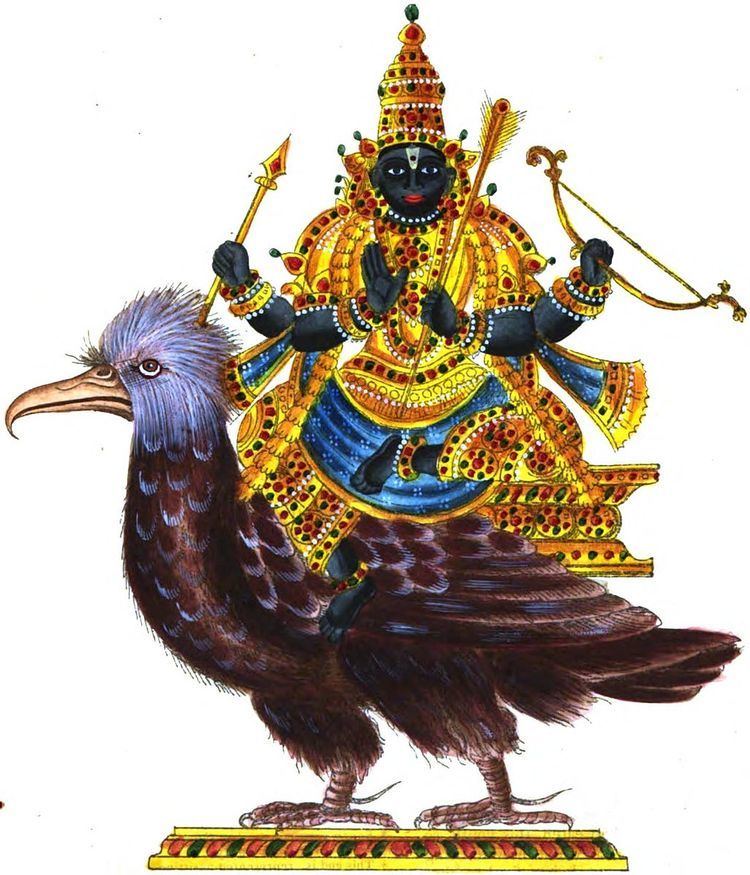Devanagari शनि Weapon Bow, Arrow Consort Jyestadevi | Planet Saturn Day Saturday | |
 | ||
Affiliation Navagraha, Medieval Hindu astrology | ||
Shani (Sanskrit: शनि, Śani) refers to planet Saturn, and is one of the 9 heavenly objects known as Navagraha in Hindu astrology. Shani is also a male deity in the Puranas, whose iconography consists of a dark (black) figure carrying a sword (or another weapon) and sitting on a buffalo (or crow or vulture).
Contents
Planet
Shani as a planet appears in various Hindu astronomical texts in Sanskrit, such as the 5th century Aryabhatiya by Aryabhatta, the 6th century Romaka by Latadeva and Panca Siddhantika by Varahamihira, the 7th century Khandakhadyaka by Brahmagupta and the 8th century Sisyadhivrddida by Lalla. These texts present Shani as one of the planets and estimate the characteristics of the respective planetary motion. Other texts such as Surya Siddhanta dated to have been complete sometime between the 5th century and 10th century present their chapters on various planets as divine knowledge linked to deities.
The manuscripts of these texts exist in slightly different versions, present Shani's motion in the skies, but vary in their data, suggesting that the text were open and revised over their lives. The texts slightly disagree in their data, in their measurements of Shani's revolutions, apogee, epicycles, nodal longitudes, orbital inclination, and other parameters. For example, both Khandakhadyaka and Surya Siddhanta of Varaha state that Shani completes 146,564 revolutions on its own axis every 4,320,000 earth years, an Epicycle of Apsis as 60 degrees, and had an apogee (aphelia) of 240 degrees in 499 CE; while another manuscript of Surya Siddhanta revises the revolutions to 146,568, the apogee to 236 degrees and 37 seconds and the Epicycle to about 49 degrees.
The 1st millennium CE Hindu scholars had estimated the time it took for sidereal revolutions of each planet including Shani, from their astronomical studies, with slightly different results:
Calendar
Shani is the basis for Shanivara – one of the seven days that make a week in the Hindu calendar. This day corresponds to Saturday – after Saturn – in the Greco-Roman convention for naming the days of the week. The zodiac and naming system of Hindu astrology, including those on Shani as Saturn, likely developed in the centuries after the arrival of Greek astrology with Alexander the Great, their zodiac signs being nearly identical.
Deity
Shani is a deity in medieval era texts, who is considered inauspicious, bringer of bad luck. He is a deity who gets angry easily and one who takes thorough revenge for whatever made him upset. In medieval Hindu literature, inconsistent mythologies sometimes refer to him as the son of Sun and Chayya (shadow), or as the son of Balarama and Revati. His alternate names include Ara, Kona and Kroda.
The fig tree called Pipal in some Indian texts is the abode of Shani (while other texts associate the same tree with Vasudeva).
In 2013, a 20-foot-tall statue of Lord Shani was established at Yerdanur in the mandal of Sangareddy, Medak district, nearly 40 kilometers from Hyderabad city. It was carved from a monolith and weighs about nine tonnes.
